3.0 Case Studies of Exempt Vehicle Use by StateThis section provides more detailed information on the exempt vehicle programs in the 13 states. Information on the enabling state legislation, program requirements, and permits or license plates issued is presented. Data on actual use by exempt vehicles is provided for those states with available information. 3.1 ARIZONA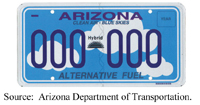 Legislation allowing AFVs to use HOV lanes in Arizona was first approved in 1997. The definition of eligible AFVs at that time followed the provisions of TEA-21. Legislation approved in 2001 added hybrids to the types of qualifying vehicles based on approval from the federal government. The initial request from ADOT to the Federal Highway Administration (FHWA) to include hybrid vehicles in the exempt HOV lane user group was not approved since hybrids were not allowed under TEA-21. Based on SAFETEA-LU, FHWA granted conditional approval to ADOT to allow hybrid vehicles use of HOV lanes. The governor authorized a pilot program in January 2007, allowing qualifying hybrid vehicles to use the HOV lanes, reducing travel times and improving trip-time reliability for individuals driving eligible vehicles. The pilot was also intended to promote energy independence, reduce fuel consumption, and support air quality. The pilot program was initiated by ADOT in February 2007. Vehicles meeting the Tier II emissions levels established under the Clean Air Act Amendments and achieving not less than 45 percent fuel efficiency in combined city-highway fuel economy were eligible for the pilot program. At the time, the Honda Insight, Toyota Prius, and Honda Civic Hybrid met the criteria. Only those makes and models continue to be eligible for the pilot program, although any model year qualifies. The pilot program allows up to 10,000 qualifying hybrid vehicles to use the HOV lanes in the Phoenix area. Currently, HOV lanes are in operation on I-10, I-17, SR 51, SR 101, and SR 202 in the Phoenix area. The HOV lanes operate on weekdays from 6:00 a.m. to 9:00 a.m. and from 3:00 p.m. to 7:00 p.m. The lanes are open to general purpose traffic at other times and on weekends. Owners of eligible hybrid vehicles must obtain a special “blue sky” energy-efficient license plate with a hybrid decal. Initially, individuals were able to obtain an alternative-fuel license plate and decal on-line or through the mail. There is an $8.00 initial application fee and $1.50 charge for postage and handling. The limit of 10,000 was reached in May 2008 and no further decals were issued. By 2011, ADOT calculated that 2,500 license plates could be made available due to those returned or not renewed. The second issuance of alternative-fuel license plates was opened on September 13, 2011. License plates were available only through on-line registration at http://www.servicearizona.com/, on a first-come, first-served basis. The cost of the plates was $10.49, including postage and handling. The 2,500 available plates sold out quickly. The following message is posted on the website. “Arizona’s Energy Efficient Pilot Program has reached the maximum limit of 10,000 special license plates issued. There are no plates available at this time. Thank you for your interest in the program.” Currently, the overall traffic volumes in the freeway HOV and general purpose lanes in the Phoenix area are monitored. Use of the HOV lanes by vehicles with energy-efficient license plates with hybrid decals is not monitored, however. 3.2 CALIFORNIA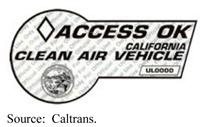 California is the only state that has approved legislation allowing specific low-emissions vehicles to access HOV lanes, adding hybrid vehicles to the authorized group, and then allowing the exemption to expire. The legislation allowing the hybrid exemption to expire created a new program for the next generation of green technology vehicles, however. Legislation approved in 1999 allowed vehicles meeting California’s low-emissions vehicle regulations to access HOV lanes in the state without meeting vehicle-occupancy requirements. Since few vehicles met these requirements, there was little impact on HOV lane use. Owners of vehicles meeting the federal ILEV definition were able to obtain white clean air vehicle stickers. No limit was placed on the number of white stickers that could be issued due to the anticipated low number of ILEVs. This program was continued in the legislation allowing hybrid vehicle use. Further, legislation passed in 2011 extended the white clean air vehicle sticker program through January 1, 2015. Decaled vehicles have been exempt from tolls on HOT lanes in the state as a matter of practice and business rules. The exception on the I-10 and I-110 HOT lanes in Los Angeles County, which are part of the federal Congestion Reduction Management (CRD) program. Legislation in 2010 requires decaled vehicles using the I-10 and I-110 HOT lanes to pay the toll until the end of the federal demonstration period on March 1, 2014. Legislation passed in 2012 was formally codified providing toll-free passage on HOT lanes to decaled vehicles, with the exception of I-10 and I-110. Legislation approved in 2004 extended the HOV lane exemption to hybrid vehicles and other vehicles meeting the state’s AT-PZEV standard and having a 45 mpg or greater fuel economy highway rating. Implementation of this provision was based on federal action allowing hybrid vehicles. The legislation directed the California Department of Transportation (Caltrans), the California Department of Motor Vehicles (DMV), the California Air Resources Board (CARB), and the California Highway Patrol (CHP) to develop and implement procedures for identifying exempt vehicles, administering the program, and monitoring use of HOV lanes. The legislation prohibited the DMV from issuing more than 75,000 yellow clean air vehicle stickers to hybrid vehicles and directed Caltrans to examine specific elements when 50,000 yellow stickers were issued. As required by state legislation, Caltrans conducted an assessment when 50,000 yellow stickers had been issued to determine if significant HOV lane breakdown had occurred due to the addition of hybrid vehicles. The factors identified in the legislation to be examined included reduction in the level-of-service (LOS), sustained stop-and-go conditions, average travel speeds slower than the adjacent general purpose freeway lanes, and consistent increases in travel times in the HOV lanes. The analysis focused primarily on the LOS measurement, as it is commonly used to assess freeway performance. A LOS C, which represents the threshold between acceptable operating conditions and breakdown conditions, was used in the determination study. Information on the number of permits issued by counties in the state was also examined. A total of 25 counties accounted for 98 percent of the 50,679 yellow clean air vehicle stickers issued by March 2006. Los Angeles County accounted for 33 percent of the total, followed by Orange County with 10 percent, Santa Clara County with 8 percent, and San Diego and Alameda counties with 7 percent each. HOV lanes are located in all of these counties. LOS data for a two-week period in April 2005 was compared with data for the same two-week period in 2006. The assessment concluded that there was no significant HOV lane breakdown directly attributable to hybrid vehicle use of the HOV lanes. The assessment found that approximately 88-to-90 percent of the monitored HOV lanes operated at a LOS C or better during the morning and afternoon peak periods in 2006. Between 10 percent and 12 percent of the HOV lane miles experienced breakdown conditions in 2006. Approximately 7 percent of the HOV lane miles experienced breakdown conditions in 2005, prior to allowing hybrid access. While the operation of some 3-to-5 percent of the HOV lane miles degraded from 2005 to 2006, it was not possible to attribute the LOS decline directly to hybrid vehicles. Finally, the assessment indicated that the operating conditions improved in almost as many HOV lane miles as declined from 2005 and 2006. In mid-2006, 75,000 yellow stickers had been issued and the DMV stopped issuing stickers. Legislation in 2006 authorized an additional 10,000 yellow stickers to be issued. These extra yellow decals were quickly taken, bringing the total to 85,000 stickers issued. The use of HOV lanes by hybrid vehicles was monitored as part of Caltrans’ ongoing data collection program. Traffic counts from 2006 on HOV lanes in Los Angeles and the San Francisco Bay Area indicate that hybrid vehicles accounted for between 5 percent and 15 percent of total users during the morning peak hour. The highest volumes of 15 percent were recorded on I-405 in Los Angeles. Peak hour hybrid volumes on SR-91, I-10, and I-605 in Los Angeles averaged approximately 6 percent. Hybrid vehicle volumes on HOV lanes in the Bay Area were lower, representing approximately 7 percent on I-80 and 5 percent on US 101. The legislation providing hybrid access to the HOV lanes in the state was allowed to expire on July 1, 2011. After that date, hybrid vehicles with the yellow clean air stickers were no longer eligible to use the HOV lanes. Vehicles with the white clean air stickers are still eligible to use the HOV lanes. The California DMV continues to issue white clean air vehicle decals for vehicles that meet California’s SULEV standard for exhaust emissions and the federal ILEV evaporative emissions standard, including certain zero-emissions vehicles. Additionally eligible for the white clean air vehicle decals are 2004 model year or older vehicles that meet the California ultra-low emissions vehicle (ULEV) standard for exhaust emissions and the federal ILEV standard and certain AT-PZEVs. As of December 31, 2012, 21,743 white clean air stickers had been issued. In addition, as of January 1, 2012, the DMV began issuing green clean air vehicle stickers to the first 40,000 applicants who purchase or lease vehicles meeting California Enhanced AT-PZEV requirements. The California Air Resources Board (CARB) identified vehicles meeting the requirements. As of December 31, 2012, 8,859 green decals had been issued. As required by MAP-21, Caltrans submitted an HOV lane degradation determination report and an HOV lane degradation action plan to the FHWA California Division in July 2013. The degradation determination report includes an analysis of the performance of HOV lanes in the state for 2011. The analysis is based on highway speed and volume data collected from the traffic monitoring system, which includes in-ground loop detectors and microwave vehicle detection systems. Data were collected and analyzed for two 180-day periods – January 1-to-June 20, 2011 and July 1-to-December 31, 2011. The analysis covers the full 1,425 lane-miles of HOV lanes in the state, although data were not available for all segments. Overall, 43 percent of the HOV lane miles were identified as degraded in the first half of the year and 49 percent were degraded in the second half. The report notes that these figures partially reflect the general overall increase in congestion on the freeway system in the latter half of the year, especially after school begins in the late summer. Caltrans further examined the level of degradation, using the following three categories:
The report notes that on freeways with HOV lanes, approximately 13 percent of VMT in the morning peak hour were in the HOV lanes and approximately 15 percent of the VMT in the afternoon peak hour were in the HOV lanes. The report further notes that given these use levels; it is difficult for Caltrans to meet the federal performance standard requirement. The report further notes that degradation in the HOV lanes increased after the sunsetting of the hybrid decal program. The degradation action plan includes both short-term and long-term strategies to reduce or eliminate degradation. The strategies include increasing enforcement, improving incident response times, improving detection, improving infrastructure, and implementing active traffic management (ATM) strategies. Infrastructure improvements include HOV lane gap closure projects, HOV lane extensions, and adding a second HOV lane. Changing occupancy levels may also be considered, but prohibiting ILEVs is not being considered at this time as it is counter to the Governor’s Executive Order to support and incentivize the purchase and use of these vehicles. The report includes an analysis and action plan for each HOV lane in the state. The 2011 degradation level is provided, along with the potential causes. The planned remediation strategies are presented and the reasons for using the strategies are described. 3.3 COLORADO The I-25 HOV lanes were opened in the mid-1990s. Initially called the Downtown Express, the HOV lanes are seven miles in length. The barrier-separated facility includes two lanes with shoulders on each side. Access is provided at both ends of the lane. The lanes operate in the inbound direction toward downtown Denver in the morning and in the outbound direction in the afternoon. A 2+ vehicle-occupancy requirement is used. In June 2006, toll paying solo drivers were allowed to use the re-named I-25 Express Lanes. The project uses electronic toll collection (ETC), with pre-set variable pricing by time-of-day. Solo drivers must obtain an EXpressToll transponder or new sticker tag and maintain an active account to use the Express Lanes. The transponders can also be used on the E-470 and the Northwest Parkway toll facilities. A License Plate Toll was introduced in January 2009, providing another toll payment option. Cameras photograph the front and rear license plates of vehicles without an EXpressToll transponder or a new sticker tag. A bill is sent one month later to the registered owner of the vehicle for all trips made in the Express Lanes. Unpaid bills become accumulated civil penalties and notices of such are sent to the vehicle owner. The current EXpressToll rates range from a low of $.50 on Saturdays, Sundays, and weekday off-peak periods to a high of $4.00 during the weekday morning and afternoon peak-periods. The License Plate Toll rate includes a surcharge of 25 percent or more on the EXpressToll rate. The License Plate Toll rates currently range from $0.75-to-$5.00. In June 2013, the High Performance Transportation Enterprise (HPTE) Board adjusted the toll rates by extending the morning peak period for another hour to 6:45 a.m. to 8:45 a.m. Legislation adopted in 1998 allowed ILEVs meeting EPA standards to use HOV lanes in the state without meeting the minimum-occupancy requirements. Qualifying vehicles are required to display a Colorado Department of Transportation (CDOT)-developed circular bright orange sticker on the front windshield, the front driver’s side rear-view mirror, or the front bumper of the vehicle. The legislation further required CDOT, in consultation with the Denver Regional Transportation District (RTD) and local authorities, to monitor use by ILEVs as part of their periodic LOS evaluations. CDOT or other authorities may restrict or eliminate HOV lane use by ILEVs if it is determined that ILEVs are causing a significant decrease in the LOS for HOVs. The legislation specifies that if the U.S. Secretary of Transportation makes a formal determination that allowing ILEVs to use HOV lanes would disqualify the state from receiving federal funds, the use shall be terminated. Legislation approved in 2003 allows hybrid vehicles, along with ILEVs, to use HOV lanes without meeting the minimum-occupancy requirements. The legislation states that allowing hybrid vehicles to use HOV lanes shall apply only if such exemption does not affect the receipt of federal funds and does not violate any federal laws or regulations. The Colorado Department of Revenue, Division of Motor Vehicles, issued “Rules for Establishing and Regulating the Use of HOV/HOT Lanes for Certain Hybrid Vehicles for the Use and Benefit of the Colorado Department of Transportation” in April 2008. The rules cover the statutory authority for allowing hybrid use of HOV/HOT lanes in the state, the identification and permitting of hybrid vehicles, and the duration of the program. The rules also address the vehicle use priority should the HOV/HOT lanes become congested due to access by hybrid vehicles. The rules further cap the number of hybrid permits to the first 2,000 qualifying hybrid vehicles. The hybrid vehicle program was initiated in May 2008. The program was scheduled to follow the SAFETEA-LU authorization, which initially terminated on September 30, 2009. The program continued following the SAFETEA-LU extensions, and the passage of MAP-21. The rules outline two types of identification for hybrid vehicle use of HOV/HOT lanes. First, hybrid vehicle owners must obtain the orange hybrid sticker. Hybrid vehicles with these stickers may access the HOV lanes on U.S. 36, Santa Fe Drive, and State Highway 82. Secondly, to use the I-25 Express Lanes a hybrid vehicle owner must also obtain an EXpressToll transponder or a new sticker tag. The transponder or tag records the hybrid vehicle as part of the automatic vehicle identification (AVI) system. When a qualifying hybrid vehicle accesses the I-25 Express Lanes, the hybrid identification is read by the toll reader and the account is not charged. There is no cost to obtain a hybrid permit. Applications can be completed on-line or submitted through the mail. A deposit is required to obtain an EXpressToll transponder and establish an account. Since hybrid vehicles are not exempt from paying tolls on E-470 or the Northwest Parkway, the deposit covers possible use of those toll facilities. Further, charging hybrid vehicles a reduced toll is one option if the Express Lanes become congested. Additionally, the transponders are used as part of the data collection process to monitor congestion and free-flow conditions in the Express Lanes. The hybrid permits and transponders are not transferable to another hybrid vehicle or to another owner. The permits and transponders must be returned, although an EXpressToll transponder can be retained by changing the vehicle’s status to a non-hybrid account. By mid-2012, the 2,000 hybrid permit limit was reached. Individuals may still apply for a hybrid permit. Applications are placed on a waiting list and new permits are issued as existing permits are returned. The CDOT I-25 Express Lanes website alerts individuals that the 2,000 permit quota has been reached, but that applications are still being accepted. The website also contains a reminder for individuals to contact CDOT if they no longer own a hybrid vehicle with an authorized permit and transponder or tag. Use of the I-25 Express lanes is monitored by CDOT. Quarterly reports are published, which include information on vehicle volumes, bus travel times, revenues and expenditures, incidents, enforcement, operational issues, and hybrid utilization. The quarterly reports for July – September 2012, October – December 2012, January – March 2013, and April – June 2013 indicate that the number of daily hybrid users has remained relatively constant over the 12-month period. Daily use of the Express Lanes by hybrid vehicles averaged between 161 and 179 vehicles a day, with slightly heavier use in the morning operating periods. The maximum daily hybrid use was between 250 and 296 vehicles. The average total daily traffic in the Express Lanes over the same time period was approximately 10,000 vehicles. Approximately 65 percent of the daily traffic is HOVs and hybrid vehicles, and 36 percent are toll-paying vehicles. Hybrid vehicles represent approximately 4 percent of the HOV volume and 2 percent of the total vehicles. 3.4 FLORIDA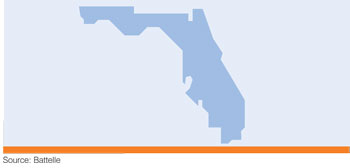 Legislation approved in 2003 allowed ILEVs that are certified and labeled in accordance with federal regulations to use HOV lanes in the state without meeting the minimum-occupancy levels. The legislation allowed hybrid vehicles to use the HOV lanes without meeting the occupancy requirements based on federal authorization. As a result, hybrid vehicles have been allowed to use HOV lanes in the state since the passage of SAFETEA-LU. At the time, HOV lanes were in operation on I-95 in Miami-Dade, Broward, and Palm Beach counties. Based on legislative direction, the Florida Department of Transportation (FDOT) and the Florida Department of Highway Safety and Motor Vehicles established a process to issue a decal and a registration certificate on an annual basis to owners of hybrid and other qualifying vehicles for HOV lane access. Hybrid vehicle owners must complete an application for an HOV decal and submit it to a county tax collector office. In addition, as noted in the following, hybrid owners must register to use the 95 Express lanes on I-95. FDOT sponsored a study in 2002 examining the potential influence of the anticipated ILEV legislation on the I-95 HOV lanes. The study found that ILEVs currently comprise a very small portion of the vehicle fleet in Florida and therefore would not impact HOV lane performance. The study also concluded that, based on limited experience in other states, allowing ILEVs to use HOV lanes provides an incentive for the purchase of these vehicles, but not enough to affect HOV lane performance. The study further noted that the number of ILEVs in the state should not increase significantly based on current definitions, but that the zero-evaporative emissions regulations could have a significant impact on ILEV sales and thus use of HOV lanes in the future. No specific study was conducted examining hybrid use of HOV lanes. Approximately seven miles of the HOV lanes on I-95 in Miami-Dade County were expanded into HOT lanes with funding through the federal Urban Partnership Agreement (UPA). The project converted the single HOV lanes in both directions to two HOT or express lanes in each direction. Called the 95 Express, the lanes are open to toll-paying customers with an active SunPass account. Variable tolling is used to maintain free-flow conditions in the express lanes. Registered vanpools, registered 3+ carpools, and registered hybrid vehicles can use the 95 Express without paying a toll. Registered transit buses, school buses, and over-the-road coaches may also use the 95 Express toll-free. Additionally, motorcycles can use the 95 Express toll-free and do not need to register. FDOT monitors use of the 95 Express and publishes monthly operations reports. As of September 2013, 8,978 toll-exempt vehicle registrations had been processed for the 95 Express. Hybrid vehicles accounted for 3,722, or 41 percent, of the registered toll-exempt vehicles. In comparison, the other registered toll-exempt vehicles included 3+ carpools, 27 percent; Miami-Dade school buses, 19 percent; Broward County and Miami-Dade County public transit buses, 11 percent; over-the-road coaches, 1.8 percent; and vanpools, 0.2 percent. A total of 1,722,467 vehicle trips were recorded using the 95 Express in September 2013. A total of 44,609, or 2.6 percent, of these trips were made by toll-exempt vehicles. Hybrid vehicles accounted for 58 percent of these toll-exempt trips, compared to 24 percent by all types of registered buses, 14 percent by 3+ HOVs, 2 percent by motorcycles, and 2 percent by vanpools. These results indicate that hybrid vehicles represent approximately 25,873, or 1.5 percent, of the total monthly trips on the 95 Express. 3.5 GEORGIA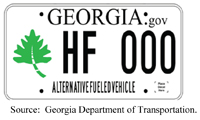 Legislation approved in 1997 allows AFVs to use HOV lanes in Georgia without meeting vehicle-occupancy requirements. Vehicles must meet requirements designated by the Georgia Department of Natural Resources. Legislation approved in 2004 extended eligibility to electric hybrid vehicles but provided that single-occupant hybrids could not use the HOV lanes unless Congress amended the existing federal legislation or action was taken by the U.S. Department of Transportation. Currently, the Georgia Department of Transportation’s (GDOT) web page with AFV and HOV information notes that hybrid vehicles do not qualify for an AFV tag. Thus, single-occupant hybrid vehicles are not allowed to use the HOV lanes in the state, including the I-85 Express HOT lanes. To use the HOV lanes, owners of AFVs must obtain an AFV license plate and tag from the Georgia Department of Revenue. An owner must complete a vehicle request form, stating the type of fuel used to propel the vehicle. The owner must also indicate the primary location where the alternative fuel will be purchased, and affirm that the vehicle will operate on the alternative fuel not less than 85 percent of the total time the vehicle is in operation. Owners are required to maintain receipts for purchases of alternative fuel for three years and provide them as requested for compliance review. The 2010 special license plate information chart lists the following costs for an AFV license plate – annual registration/decal fee, $20; manufacturing fee, $20; special tag fee, $35; and special tag renewal fee. These fees are similar to those for the other special license plates. No inspection of the vehicle is required. The I-85 Express Lanes, which expanded the I-85 HOV lanes to HOT lanes in 2011 as part of the federal CRD program, allows vehicles with proper AFV license plates, which do not include hybrids. No data was available on the number of plates issued by the Georgia Department of Revenue or on the use of the I-85 Express Lanes by vehicles with AFV license plates. 3.6 HAWAII Legislation passed in 1997 provided a number of incentives for electric vehicle ownership in Hawaii. These incentives include use of the HOV lanes in the state without meeting the vehicle-occupancy requirements and exemption from parking fees charged by any non-federal governmental authority. Motor vehicle registration fees were also waived on electric vehicles for a five-year period after passage of the act. HOV lanes are in operation in the Honolulu area on H-1, H-2, H-201, Route 92, and Route 72. Motor vehicles are registered by county in Hawaii. Individuals purchasing or importing electric vehicles obtain an electric vehicle license plate when they register their vehicle. Drivers of these vehicles are then able to use the HOV lanes. No data is available on the use of the HOV lanes in Hawaii by electric vehicles. 3.7 MARYLAND Legislation passed by the Maryland General Assembly in 2010 allows plug-in electric vehicles (PIVs) to use HOV lanes in the state without meeting the vehicle-occupancy requirements. Currently, HOV lanes are in operation on I-270 and US 50. The PIVs must be titled and registered in Maryland, and must display a valid HOV permit. To quality for use of the HOV lanes, PIVs must also meet the following six criteria:
HOV lanes currently operate on I-270 and US 50 in Maryland. Operation of the HOV lanes on I-270 was initiated in September 1993 with the opening of the HOV lane on the northbound East Spur. The HOV lanes were completed in December 1996. The southbound HOV lane on I-270 extends from I-370 to Capital Beltway (I-495). The northbound HOV lane extends from the Capital Beltway to MD 121 (Clarksburg Road). The HOV lanes operate in peak periods, peak direction of travel – from 6:00 a.m. to 9:00 a.m. in the southbound direction and from 3:30 p.m. to 6:30 p.m. in the northbound direction. The HOV lanes are open to general purpose traffic at other times. The HOV lanes on US 50 opened in October 2002. The US 50 HOV lanes extend from the Capital Beltway to US 301 (Crain Highway), a distance of 7.5 miles. The HOV designation is in effect 24-hours a day/7 days a week. The legislation authorized the Maryland Motor Vehicle Administration (MVA) to issue PIV permits. Vehicles owners must complete an application for a PIV permit. Although the legislation authorizes the MVA to charge up to $20 for a PIV permit, no fee is currently being assessed. The MVA currently provides the HOV permits/stickers to PIV dealerships for them to distribute to PIV buyers. The MVA also provides HOV PIV permits to qualifying PIV owners who did not purchase their vehicle at a dealership. The PIV HOV permits currently expire on September 30, 2017, when the law is scheduled to sunset. The legislation requires that the MVA and State Highway Administration (SHA) issue a joint report annually to the governor and the General Assembly on the effect of PIV use of the HOV lanes. The reports document the number of HOV permits issued to PIVs. The December 2013 report notes that 988 permits were issued between October 2010 and September 2013 as highlighted in Table 4. According to the MVA, there are 1,764 PIVs registered in Maryland. Approximately 56 percent of the PIVs in the state have registered for an HOV permit. The highest registration was recorded in September 2013, with 124 PIV HOV permits issued.
The SHA did not conduct a formal study of the impacts of the PIVs on the two HOV lanes based on only 988 permits issued. The SHA concluded that this number of permits has no impact on HOV operations at the current time. The report notes that even if all 988 PIVs used the HOV lanes at the same time, the impact on operation of the lanes would be marginal. The report further notes the growth in the production and sales of PIVs and the need for ongoing monitoring. 3.8 NEW JERSEY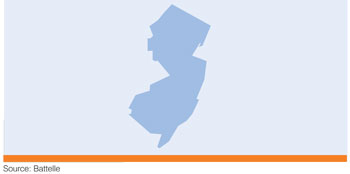 The New Jersey Turnpike Authority allows hybrid vehicles to use the HOV lanes on the turnpike without meeting the vehicle-occupancy requirement. The hybrid access was first authorized by the New Jersey Turnpike Authority in 2006 and re-confirmed in 2009. The HOV lanes are located on the turnpike between Interchange 11 in Woodbridge and Interchange 14 in Newark. The HOV lanes operate on weekdays in the northbound direction from 6:00 a.m. to 9:00 a.m. and in the southbound direction from 4:00 p.m. to 7:00 p.m. Hybrid vehicles must still pay the appropriate tolls, but may use the HOV lanes during the restricted time periods. No special tags, stickers, license plates, or transponders are required. The list of qualifying hybrids is provided to enforcement personnel who monitor the use of the HOV lanes. Eligible hybrids include the Ford Escape Hybrid, Mazda Tribute Hybrid, Toyota Prius Hybrid, Toyota Highlander Hybrid, Honda Insight Hybrid, Honda Civic Hybrid, Honda Accord Hybrid, and Lexus RX400H. Use of the HOV lanes by hybrid vehicles is not monitored since the owners must still pay the appropriate toll. 3.9 NEW YORK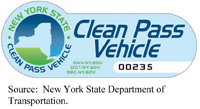 The Clean Pass pilot program, which began in 2006, allows eligible hybrid vehicles to use the HOV lanes on the Long Island Expressway (LIE). Clean Pass was initiated as part of the then governor’s Strategic Energy Action Plan. The LIE Clean Pass is sponsored through a partnership involving the New York State Department of Transportation (NYSDOT), the New York State Department of Motor Vehicles (NYSDMV), and the State Department of Environmental Conservation (DEC). Owners of eligible hybrid vehicles apply to the NYSDMV to register for the program. The NYSDMV issues four stickers to eligible vehicle owners, which must be placed on the front, rear, and each side of the vehicle. The NYSDMV and the NYSDOT monitor a number of elements of the Clean Pass program. The NYSDMV tracks the total Clean Pass vehicles registered statewide and by county. The number of hybrid vehicles registered in the state by county is also recorded. A comparison can be made of eligible hybrid vehicles by county and registered Clean Pass vehicles by county using these data. Sales of hybrid vehicles in the U.S. are monitored using commercially-available information. A total of 2,119 Clean Pass stickers were issued by the end of 2006. A total of 19,895 Clean Pass stickers had been issued as of October 1, 2013. Approximately 94 percent of the eligible vehicles in Suffolk County and 64 percent of the eligible vehicles in Nassau County have been registered for the program. NYSDOT has an ongoing program monitoring use of the LIE. Traffic counts from October, 2006, indicate that hybrid vehicles accounted for between 15-to-90 vehicles or 1 percent and 6 percent of the HOV lane volumes during the morning and the afternoon peak hours. Traffic counts in 2010 and 2011 indicate that the number of Clean Pass vehicles had increased to between 400 and 500 of the 1,500-to-1,600 vehicles using the LIE HOV lanes during the morning peak hour. As of October 2013, there was a maximum of 681 Clean Pass vehicles at exit 50, with an average of 551 Clean Pass vehicles across the length of the HOV lanes. The eastbound peak had a maximum of 520 Clean Pass vehicles at exit 50, with an average of 405 Clean Pass vehicles across the length of the HOV lanes. Thus, Clean Pass vehicles currently account for approximately 26-to-31 percent of all peak hour vehicles using the LIE HOV lanes. The percent of carpools using the LIE has declined over this same time period. 3.10 NORTH CAROLINA Legislation passed in 2011 by the General Assembly of North Carolina allows PIVs, dedicated natural gas vehicles, and fuel cell electric vehicles to use the HOV lanes in the state without meeting the vehicle-occupancy requirements. The legislation does not include hybrid vehicles. Currently, the only HOV lanes in North Carolina are on I-77 in the Charlotte area. The North Carolina Department of Transportation website notes that gas-electric hybrid vehicles are not allowed to use the HOV lanes. 3.11 TENNESSEE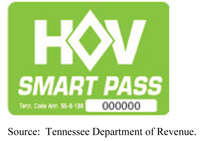 The HOV Smart Pass program was initiated in 2009, allowing hybrid vehicles to use the HOV lanes in the state without meeting the occupancy requirements. HOV lanes are currently in operation on I-65, I-40, and I-24 in Nashville and on I-40 and I-55 in Memphis. The Tennessee Department of Revenue is responsible for the Smart Pass program; the Tennessee Department of Transportation (TDOT) is responsible for planning, designing, and operating the HOV lanes; and the Tennessee Department of Safety is responsible for enforcing the HOV lanes. Owners of hybrid and other qualifying vehicles can apply for a Smart Pass decal at no cost by e-mail, fax, or mail. The decal must be displayed to drive in an HOV lane without meeting the vehicle-occupancy requirement. The required placement of the decal is the outside of the rear vehicle window on the lower right or passenger side. As of November, 2013, 2,133 HOV Smart Pass decals had been issued by the Tennessee Department of Revenue. TDOT does not currently collect data on use of the HOV lanes by vehicles with HOV Smart Pass decals. Plans are underway to begin collecting these data, however. 3.12 UTAH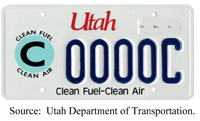 Legislation approved in 2001 allowed vehicles with clean fuel special group license plates to use HOV lanes in the state without meeting minimum-occupancy requirements. The initial exemption was scheduled to expire December 31, 2005, but was continued through legislative extensions. To qualify for a clean fuel license plate, a vehicle must meet EPA standards. An applicant must annually obtain a clean fuel vehicle permit. As of the fall of 2004, there were approximately 659 active vehicle registrations with clean fuel license plates in the state. This figure includes AFVs in agency fleets. Based on new state legislation, the Utah Department of Transportation (UDOT) began issuing a Clean Fuel Vehicle Decal to new applicants on July 1, 2011. The new C Decal program replaced the clean fuel license plate program for hybrid access to the I-15 Express Lanes with only the driver and without paying a toll. The change was made because the definition of “clean fuel” used in the previous legislation did not match the more stringent federal definition. Individuals with an existing clean fuel license plate were notified if their vehicle did not qualify for a new C Decal. These individuals did not receive a new permit and C Decal. Individuals with an existing clean fuel license plate whose vehicle did qualify under the new requirements received a new C Decal. Individuals with qualifying vehicles can continue to obtain C Decals, as UDOT determined the I-15 Express Lanes can still accommodate additional C Decal vehicles without impacting carpools and HOT vehicles. As of November 2013, 5,555 C Decals had been issued to hybrid vehicles, as well as compressed natural gas (CNG) and electric vehicles. No data was found on the use of the I-15 Express Lanes by vehicles with the C Decals. 3.13 VIRGINIA Virginia was the first state to allow hybrid vehicles to use HOV lanes without meeting vehicle-occupancy requirements. Hybrid vehicles have been able to access HOV lanes in the state since 2000, before it was allowed by federal legislation. Virginia provides a good example of an extensive ongoing HOV lane monitoring program conducted through the coordinated efforts of the Virginia Department of Transportation (VDOT), the Metropolitan Washington Council of Governments (WASHCOG), and the Virginia State Patrol. This monitoring program documented congestion in the HOV lanes in northern Virginia from hybrid use. Virginia has addressed this congestion by changing the clean special fuel license plate design and limiting hybrid vehicle access to specific HOV lanes based on the license plate design. HOV lanes are in operation in northern Virginia and in the Hampton Roads, Norfolk, and Newport News area in southeastern Virginia. Three of the HOV lanes in northern Virginia – I-95, I-395, and I-66 – serve traffic in and out of Washington, D.C. The fourth HOV lane in northern Virginia is on the Dulles Toll Road, which feeds into I-66. HOV lanes in the Hampton Roads area include I-64 and I-264. Legislation approved in Virginia in 1993 established a clean special fuel license plate for AFVs. State legislation approved in 1994 allowed vehicles with clean special fuel license plates to use the HOV lanes in Virginia without meeting the minimum-occupancy requirements. Subsequent legislation has extended the sunset date for the HOV lane access and limited use of some HOV facilities by changing the design of the required clean special fuel license plate. Three different special fuel license plates are currently in use. In 2013, the Virginia General Assembly extended the exemption indefinitely. The 2013 legislation also requires that the exemption must be compliant with federal laws. It further requires that the Commissioner of Highways shall provide annually to the Chairman of the Senate and House of Delegates Committees on Transportation traffic volumes on the HOV facilities that result in a degradation condition as defined by federal law and as reported to FHWA. Hybrid vehicles, which became available in the state in 2000, were initially determined not to be eligible for the clean special fuel license plates by the Virginia DMV, in consultation with the Virginia Department of Environmental Quality. After several citizens approached their state legislators about the issue, the decision was reversed. Only vehicles with clean special fuel license plates are authorized to use the HOV lanes in Virginia without meeting the occupancy requirements. An individual must apply to the Virginia DMV for the special plates. A vehicle owner must submit the application and documentation to the DMV headquarters Special License Plate and Consignment Center. Staff at the Center review the application and documentation and determine if the vehicle qualifies for the clean special fuel license plate. The special plates and an invoice are sent to the owner of qualifying vehicles. Table 5 presents the number of active clean special fuel license plates for different time periods. During the six years from 1994 through 1999 when only AFVs qualified, there were 78 active clean special fuel license plates. By June 2006, with hybrids qualifying for the HOV exemption, there were 15,485 clean special fuel license plates. By June 2011, there were 26,829 active clean special fuel license plates issued. The number of active clean special fuel license plates declined slightly to 25,646 in October 2013.
1Only AFVs eligible for clean special fuel license plates and allowed to use all HOV lanes in the state.
2Hybrid vehicles eligible for clean special fuel license plates and allowed to use all HOV lanes in the state. 3New clean special fuel license plates design implemented on July 1, 2006. Use of the HOV lanes on I-95 and I-395 limited to vehicles with the old clean special fuel license plates. 4Third clean special fuel license plate design implemented on July 1, 2011. Use of the HOV lanes on I-66 limited to vehicles with the first two clean special fuel license plates. This increase was directly attributed to hybrid vehicle owners applying for the clean special fuel license plates. Hybrid vehicles account for 99.2 percent of the total active clean special fuel license plates. Further, 84.4 percent of the existing special fuel vehicle plates were issued in counties and cities in northern Virginia, which are served by the I-95, I-395, I-66, and Dulles Toll Road HOV lanes. WASHCOG, in coordination with VDOT, has an ongoing program for monitoring and reporting on the use of HOV facilities in northern Virginia. In the fall of 2003, clean special fuel vehicles accounted for between 2 percent and 12 percent of the HOV volumes during the peak periods on the different HOV facilities in northern Virginia. Counts from October 2004 indicated that clean special fuel vehicles accounted for between 11 percent and 17 percent of the vehicles in the I-95 HOV lanes during the 6:00 a.m.-to-9:00 a.m. peak period in the northbound direction. These percentages translate into a range of 844-to-1,422 vehicles with clean special fuel license plates using the HOV lanes during the three-hour period, and the corresponding total vehicle volumes in the HOV lane ranged from 7,994 to 8,450. In 2005 and 2006, hybrid vehicles accounted for approximately 24 percent of the peak-hour vehicles using the I-95 HOV lane. The Virginia HOV Enforcement Task Force examined hybrid vehicle use of the HOV lanes and other issues. The Task Force was established in 2003 by the Virginia Secretaries of Transportation and Public Safety in response to concerns from numerous groups about the large numbers of non-HOV vehicles in the HOV lanes during the restricted time period. The Task Force included representatives from state, regional, and local transportation and enforcement agencies. Reports issued by the Task Force in 2003 and 2005 included recommendations for addressing these concerns. In an effort to limit or cap the number of clean fuel vehicles using the I-95/I-395 HOV lanes, legislation approved in 2006 required that a new distinctively different design be used for clean special fuel license plates issued after July 1, 2006. The legislation limits the clean fuel exemption on the HOV lanes in the I-95/I-395 corridor to vehicles registered with and displaying the clean special fuel license plates issued prior to July 1, 2006. Individuals with clean special fuel license plates registered to vehicles before July 1, 2006 are able to renew or transfer their plates to a newly purchased qualifying vehicle after July 1, 2006 and continue to use the I-95/I-395 HOV lanes. The legislation also increased the fee for the clean special fuel license plates from $10 to $25. For each $25 fee collected after the first 1,000 registrations, $15 is paid to the State Treasurer and credited to a special, non-revenue HOV Enforcement Fund for use by the Virginia State Police for enhanced HOV enforcement. In October 2010, hybrid vehicles accounted for between 13.3-to-14.8 percent of peak hour vehicles on I-66 inside the Beltway and 10-to-14.6 percent of peak hour vehicles on I-66 outside the Beltway. On I-395, hybrid vehicles accounted for between 11.8 percent and 14.1 percent and between 13.9 percent and 15.3 percent on I-95. The hybrid volumes on I-66 resulted in legislation establishing a new clean special fuel license plate and limiting use of I-66 to vehicles with either the special fuel license plates issued before July 1, 2006 or between July 1, 2006 and July 1, 2011. As noted previously, use of the HOV lanes in the state by vehicles with all of the clean special fuel license plates is currently scheduled to expire on July 2, 2012, although the Virginia General Assembly is considering extending this date. As presented in Table 5, the number of active clean special fuel license plates in January 2012 and October 2013 recorded a decline from the number in June 2011. As of July 1, 2011, hybrid vehicle owners applying for new clean special fuel license plates can only use the HOV lanes on the Dulles Toll Road and those in the Hampton Road areas, not the HOV lanes on I-95, I-395, and I-66. It appears the restrictions on use of the HOV lanes in the congested travel corridors serving Washington, D.C. have lowered the demand for the clean special fuel license plates. Figure 1 illustrates the three different clean special fuel license plates currently in use. The restriction on use of the different HOV lanes is also summarized.
Source: Virginia Department of Transportation
Figure 1. Virginia Clean Special License Plates VDOT’s June 2013 report on HOV hybrid exemption certification indicates that HOV lanes in the Commonwealth are operating within the requirements of MAP-21, with the exception of I-66 outside the Beltway. The analysis, which examined operation of the HOV lanes from April 1-to-June 30, 2013, found I-66 to be degraded approximately 20 percent of the time in the morning peak period and almost 31 percent in the afternoon peak-period. The VDOT degradation mitigation plan for I-66 outside the Beltway includes five phases. These phases are increasing HOV enforcement and public awareness, improving available capacity management by implementing ATM and reducing merge activities, adding managed lanes, discontinuing clean fuel (non-HOV) vehicles, and increasing the vehicle-occupancy requirements from 2+ to 3+. | |||||||||||||||||||||||||||||||
|
United States Department of Transportation - Federal Highway Administration |
||